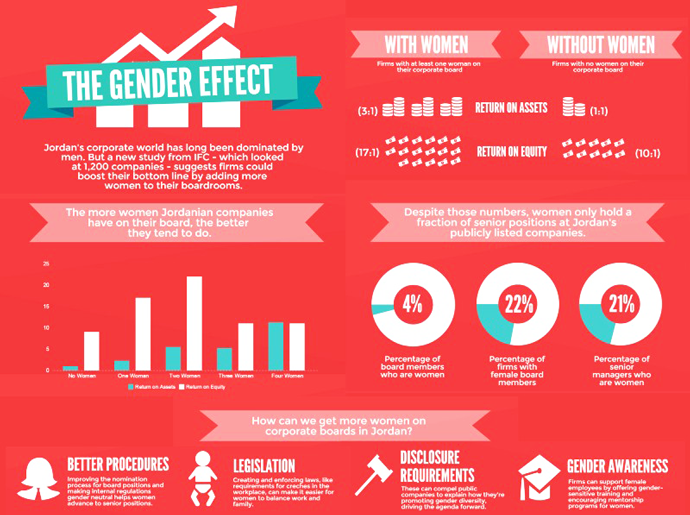Female board members can dramatically improve the fortunes of public companies — and the Middle East
While the Middle East has made strides towards gender equality in recent years, the upper echelons of its corporate world are still dominated by men.
Nowhere is that more apparent than in Jordan. Women there hold just 4% of all board of directors’ seats, and nearly four-fifths of firms don’t have any women on their boards. Those numbers pale in comparison with many other countries, including the United Kingdom, where 25% of all board members are women.
But a new study from IFC, a member of the World Bank Group, suggests that companies would do well to inject some female leadership into their ranks — a finding that has deep implications for the entire region.
The report, released this week, shows that companies with at least one female board member vastly outperform those with all-male boards. In fact, those firms posted a return on assets — a key measure of profitability — of 3 to 1, according to the study, which analyzed data from 2012. That was three times better than the ratio for companies directed exclusively by men. When you look at return on equity — another indicator of a firm’s financial health — companies with female board members scored almost twice as well as those without (18 to 1 vs. 10 to 1).
These are telling numbers for a region grappling with high unemployment and lackluster growth. With many Middle Eastern governments under fiscal pressure, it will be up to the private sector to create jobs and drive economic development in the coming years. And strong, vital corporations — read: Those led by women — will play a crucial role in that process.
But why are women such a vital part of corporate boards? There are a few reasons. First, they tend to bring a fresh perspective to issues and often challenge the status quo. That helps shatter groupthink, which is dangerous for boards, and leads to better decision making. As well, women are responsible for the majority of consumer purchases, and having female leaders helps companies better understand their main customers.
The dilemma facing policy makers in the Middle East is this: How can you get companies to put more women on their boards? One way is to introduce quotas, which help break down the social barriers facing women in the workplace. Countries from India to Norway have gone that route, and have seen success in diversifying their boardrooms.

Another key is to create a friendlier working environment for women, who still carry most of the burden at home. Governments can do this by passing and, crucially, enforcing laws that promote gender equality and allow women to succeed in the business world.
At the same time, companies should embrace strategies that help women and men balance work and family life. They can do that by instituting flex time, placing nurseries in the workplace, and launching mentorship and sponsorship programs.
We have the tools we need to boost female participation in the upper reaches of the corporate world — including IFC’s Women on Boards and SheWorks initiatives. SheWorks is a highly collaborative private sector partnership focused on creating environments where all talent can thrive including women in top leadership positions. Given the dramatic impact that female directors can have on a company’s performance and the tenuous state of the region’s economy, it’s time to increase women’s voices in the board room for the benefit of all.
This blog post was originally published on Medium.


Join the Conversation